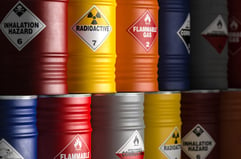
Since the 1980s, the Occupational Safety and Health Administration (OSHA) has required most employers to protect their workers from workplace chemical hazards, and to train workers to protect themselves. Most employers are subject to OSHA’s Hazard Communication Standard (HCS; 29 CFR 1910.1200), or to variants imposed by states delegated OSHA’s authority. OSHA revises its HCS from time to time; by far the biggest revisions were adopted in March 2012, when OSHA recast HCS to align it with the United Nations-sponsored Globally Harmonized System of Classification and Labeling of Chemicals (GHS). OSHA’s 2012 revisions conformed the US to GHS Revision 3, which was issued internationally in 2002. The most obvious change was the adoption of Safety Data Sheets (SDSs) to replace longstanding Material Safety Data Sheets (MSDSs), but employers faced a series of deadlines during 2013-2016.
In February 2021, OSHA has issued a Notice of Proposed Rulemaking proposing new revisions to its 2012 HCS. These reflect GHS changes through Revision 7, which was published in 2017. The proposal spans 256 pages in the Federal Register; most changes are to technical information required for hazard definition, hazard determination, and hazard information and management. The remainder of this note summarizes the major proposed changes, based on the subsection or appendix in which the changes are proposed.1910.1200(a) Purpose
The only proposed change is to update the reference to GHS from version 3 to 7.
1910.1200(b) Scope and Application
The only proposed change is applicability to “nuisance particulates” to expand potential types of hazards by adding “or other hazards” to the present choice of physical or health hazards. The Federal Register preamble explains that OSHA intends to ensure consideration of potential “hazards not otherwise classified (HNOC),” based on scientific information outside the general physical and health considerations.
1910.1200(c) Definitions
OSHA proposes minor revisions, additions and deletions in its list of definitions:
-
“Bulk shipment” where the transportation vehicle is the direct container (e.g., tanker truck).
-
“Combustible dust” which means “finely divided solid particles of a substance or mixture that are liable to catch fire or explode on ignition when dispersed in air or other oxidizing media.”
-
“Exposure or exposed” is also expanded from physical or health hazard to any hazardous chemical.
-
“Gas” is defined, to include gases and materials with vapor pressures above specified levels.
-
“Immediate outer package” is defined, to mean “the first package enclosing the container of hazardous chemical.”
-
“Liquid” is defined.
-
“Physical hazard” is redefined, adding “desensitized explosive” as a class of hazard.
-
“Physician or other licensed health care professional (PLHCP)” is defined.
-
“Pyrophoric gas” definition is deleted, although the term is still defined in technical appendices.
-
“Released for shipment” is defined to mean “a chemical that has been packaged and labeled in the manner in which it will be distributed or sold.”
-
“Solid” is defined as a material that does not meet the definitions of gas or liquid.
1910.1200(d) Hazard Classification
HCS requires chemical manufacturers, importers and end users (i.e., most employers) to evaluate chemicals produced, imported or used in their workplaces. OSHA proposes changes to these requirements:
-
Organizations are to evaluate hazards “under normal conditions of use and foreseeable emergencies. The hazard classification shall include any hazards associated with a change in the chemical’s physical form or resulting from a reaction with other chemicals under normal conditions of use”
1910.1200(e) Written hazard communication program
No substantive changes are proposed, but note that other revisions may necessitate revisions.
1910.1200(f) Labels and other forms of warning
OSHA is proposing changes to several labeling provisions
-
Shipping container labels are not required to include within identified hazards those “resulting from a reaction with other chemicals under normal conditions of use.”
-
Container labels must include the date the chemical is released for shipment
-
For bulk shipments the label may be on the immediate container, be transmitted with shipping papers or bills of lading, or be provided by other means in order to be immediately available to workers in printed form on the receiving end of shipment.
-
If the label presents the pictogram required by the Department of Transportation (DOT), the label otherwise required by OSHA is not required.
-
The requirement that organizations update labels to reflect new information does not apply to chemicals that have been released for shipment.
-
New requirements are adopted for small containers
-
less than 100 ml – abbreviated label must include: product identifier; pictogram(s); signal word; manufacturer’s name and phone number; and statement that the full label information for the hazardous chemical is provided on the immediate outer package
-
3 ml or less, if abbreviated label would interfere with use – pictogram
1910.1200(g) Safety data sheets
No substantive changes are proposed, but note that other revisions may necessitate revisions.
1910.1200(h) Employee information and training
No substantive changes are proposed, but note that other revisions may necessitate revisions.
1910.1200(i) Trade secrets
Requirements for trade secret claims will allow disclosure of constituent concentrations in specified ranges.
1910.1200(j) Effective dates
The proposal includes placeholders for when OSHA would require compliance with final versions of these revisions:
-
Revised rule effective 60 days after publication in Federal Register
-
Chemical manufacturers, importers, and distributors evaluating mixtures - comply within 2 years
1910.1200 Appendix A – Health hazard criteria
This appendix provides details about how organizations are to consider health hazards. Proposed changes include:
-
Where impurities, additives or individual constituents of a substance or mixture have been identified and are themselves classified, they should be considered in making hazard and hazard class determinations.
-
Significant changes are made for several hazard class determinations, particularly: acute toxicity, skin corrosion/irritation, serious eye damage and eye irritation, respiratory or skin sensitization, and aspiration hazard.
1910.1200 Appendix B – Physical hazard criteria
This appendix provides details about how organizations are to consider physical hazards. Proposed changes include:
-
Significant changes are made for most hazard class determinations, particularly: flammable gases, aerosols (recast from flammable aerosols), oxidizing gases, oxidizing solids, and desensitized explosives.
1910.1200 Appendix C – Allocation of label elements
This appendix provides examples of label pictograms, and details about how organizations are to consider hazards to determine which pictograms apply. Extensive changes are made, broadly consistent with the changes to definitions and hazard evaluations.
1910.1200 Appendix D – Safety data sheets
This appendix identifies the sections that are to be contained in each SDS, and provides some descriptive information. The proposal makes conforming changes where necessary to match the revisions discussed above.
What happens next?
Comments can be submitted on this OSHA proposal until May 19, 2021 (OSHA originally set the deadline as April 19, but has extended it). OSHA will review comments and determine if and when to finalize its proposal. To the extent that most changes reflect technical adjustments to conform US requirements to the international requirements in the GHS, this can be expected to proceed smoothly. If the final revisions retain the proposed compliance timelines, organizations will have two additional years to comply.
Self-evaluation checklist
Does the organization have workplaces that are required to create HCS programs to protect employees from chemical hazards?
Do onsite materials subject to HCS requirements include any for which OSHA’s proposed HCS revisions would make changes in the labeling or other information required?
Where can I go for more information?
● OSHA’s Hazard Communication web portal
● OSHA proposed revisions to HCS
- redline/strikeout of proposed changes
- 4/12/21 Federal Register (extending comment deadline)
● United Nations Economic Commission for Europe “About the GHS” web portal
About the Author
 Jon Elliott is President of Touchstone Environmental and has been a major contributor to STP’s product range for over 30 years.
Jon Elliott is President of Touchstone Environmental and has been a major contributor to STP’s product range for over 30 years.
Mr. Elliott has a diverse educational background. In addition to his Juris Doctor (University of California, Boalt Hall School of Law, 1981), he holds a Master of Public Policy (Goldman School of Public Policy [GSPP], UC Berkeley, 1980), and a Bachelor of Science in Mechanical Engineering (Princeton University, 1977).
Mr. Elliott is active in professional and community organizations. In addition, he is a past chairman of the Board of Directors of the GSPP Alumni Association, and past member of the Executive Committee of the State Bar of California's Environmental Law Section (including past chair of its Legislative Committee).
You may contact Mr. Elliott directly at: tei@ix.netcom.com

